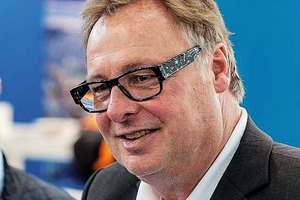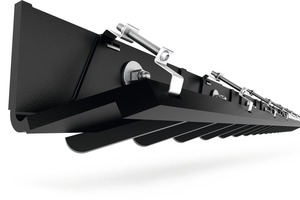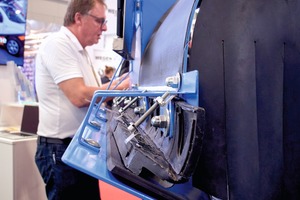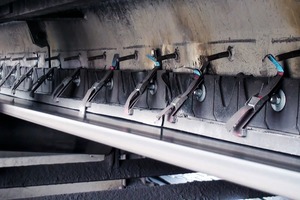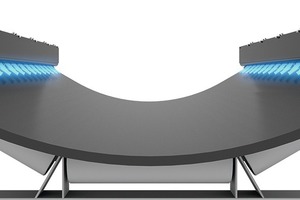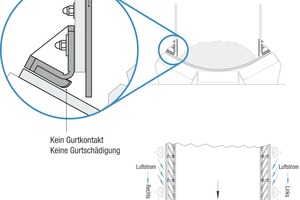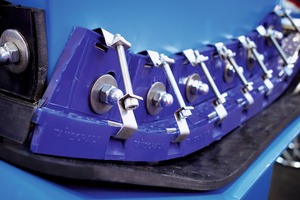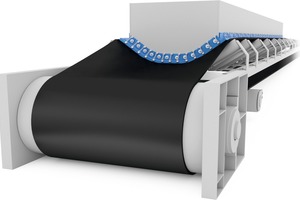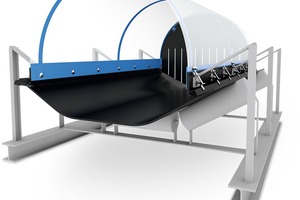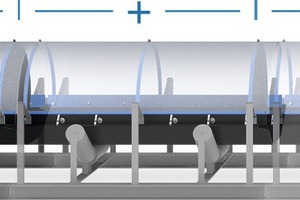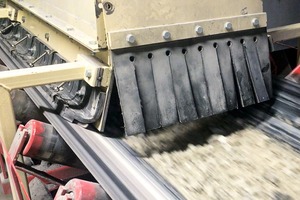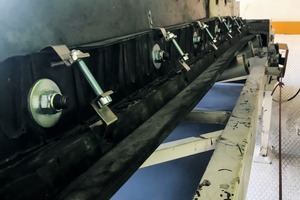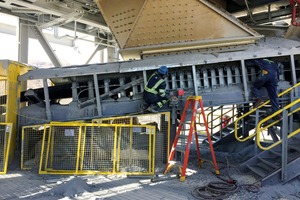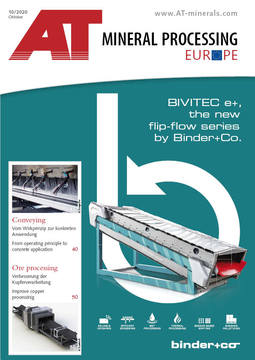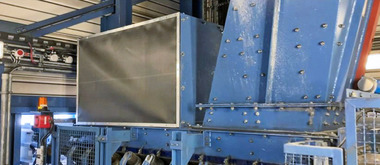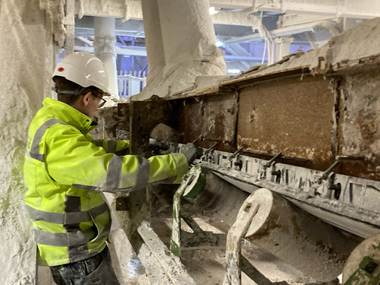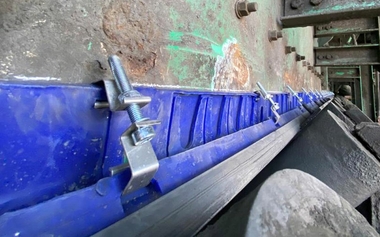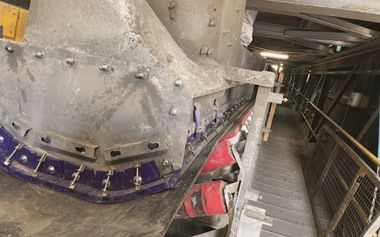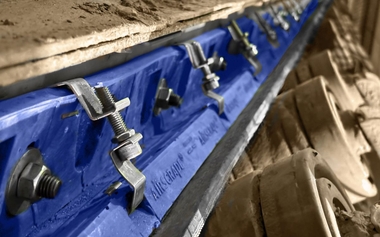Physically preventing dust emissions at conveyor belts and
belt transfers
Many solutions have already been developed to prevent dust emissions at special sections of conveyor belt systems and at transfer points. All measures taken for this purpose serve to protect the people working in the surrounding area, to keep the production environment clean and often to provide explosion protection. However, most of the classic dust prevention methods also involve risks and side effects such as increased wear and tear, causing plant operators to face different problems. Against this background of experience, the founder of the ScrapeTec Trading GmbH, Wilfried Dünnwald, developed AirScrape, a system that does not have any wear-increasing flaws. It also has a triple positive effect by keeping fine dust particles in the conveying area, reliably preventing spillage and – since it works without belt contact – virtually eliminating maintenance work.
1 Technology and mode of operation
Under the AirScrape brand, a patented and German-made skirting system for belt conveyors made its way into worldwide applications about seven years ago. The contact-free working AirScrape elements are attached to the sides of neuralgic areas of belt conveyors. A special design and the precisely balanced gap, deliberately left open, between the belt surface and the innovative skirting are responsible for the optimal mode of operation. Following physical laws, a loaded, running belt already generates a slight air suction. The slanted lamellas of the AirScrape, oriented in the running direction, now act as reliable airflow amplifiers. By floating contact-free above the belt surface at a defined distance, the innovative skirting makes use of the so-called Venturi effect: air from outside is thus drawn towards the center of the belt, creating a negative pressure in the transport area. Fine material and dust particles cannot counteract this pressure and are forced to remain in the conveying area. Coarse material that is pushing outwards can withstand this suction, but the lamellas reliably guide it back to the center of the belt.
As a result of combining these effects, the durable, easy-to-install system reliably prevents spillage and dust generation at transfer points and other critical belt areas. The comparison with other systems is also positive from a wear and tear point of view. Thanks to the contact-free operation of the AirScrape, unlike classic skirting, the belt is not exposed to any undesired frictional wear. This has a positive effect on the belt service life, while the maintenance requirements shrink to a minimum towards zero when used as intended.
In order to further optimize the contact-free AirScrape principle and achieve maximum effects in belt dedusting and cleaning, the manufacturer ScrapeTec Trading has developed additional components and supplementary products, which will be discussed later in this article.
2 Construction and assembly
The AirScrape as such consists of a low-wear polyurethane carrier unit. The inclined lamellas are made of Hardox steel > 360 HB or, if required, of stainless steel, depending on the specifications of the corresponding industry. The materials are adapted to application scenarios with temperatures from -30 ° to +85 °C. If required, special qualities are available, e.g. for underground applications or according to desired properties (high temperature resistant, antistatic, flame resistant, etc.). Depending on need, the AirScrape modules of 2 m length can be combined in right and left versions up to the desired length. The conditions of a conveyor system determine whether the AirScrape size Large (L), Medium (M) or Small (S) can be installed, whereby these size specifications refer to the lamella design. The size selection itself depends on the loading width of the conveyor belt and the necessary load-free side area where the AirScrape can be mounted in order to defuse maximally dust-relevant transfer scenarios in bulk material transport.
In contrast to the space provided for assembly, belt speeds and belt widths are not relevant for the efficiency of the skirting. Although the performance of the system is the same when using an S-, M- or L-AirScrape, it is recommended to use the widest possible AirScrape with regard to the lamellas. This provides additional lifetime advantages for the durable system, as the lamellas of the larger units are naturally longer and thicker. Since their function also consists in returning coarse, outward pushing material to the center, this increase in size and mass is a long-term advantage.
The standard length of the AirScrape modules has a positive effect on the ease of installation, for example on the sidewall of chutes in transfer areas. If further belt areas are to be included, suitable fastening options will be decided upon according to the individual situation on site.
3 Requirements and application limits
In general, while new equipment can easily be adapted to the use of an AirScrape, retrofitting requires a state-of-the-art transfer situation. Furthermore, the conveyor belt must neither run nor sag in the feeding area. If this is the case, but an AirScrape application is desired, suitable belt guides are additionally needed. These include rollers installed close together in the middle or a transfer table. Laterally, a partial straightening of the outer belt area is achieved, for example by choosing a sliding beam construction instead of rollers. The specific transfer situation is also decisive. Based on comprehensive practical experience, the manufacturer ScrapeTec Trading can make reliable statements in this regard.
The ideal sealing is provided by a wear plate on the inside of the chute wall without belt contact (distance between belt and plate 5 – 10 mm), while from the outside the AirScrape acts at the ideal angle and with an optimal distance to the belt. The functional unit of the AirScrape with its lamellas is height-adjustable via the tensioning elements and can thus be optimally adapted to the course and shape of the conveyor belt. With a central load, the best possible result is thereby achieved. In the case of off-center loading, instead of a straight wear plate on the inside, it is recommended to install a so-called natural slope or deflector plate (T-shape), which runs out wedge-shaped in the conveying direction. This special plate not only forces the freshly fed material directly into the center of the belt, but also ensures that the required air gap at the edges is not buried by freshly fed material, thus deactivating the AirScrape effect.
The fact that the suppliers of the system themselves have practical experience and can therefore find flexible answers to the most varied demands and application conditions, inter alia, with the aid of adapter plates, is proven by many references. The wish to use existing clamping systems for the AirScrape application can also be fulfilled, provided that the local conditions ensure the effectiveness of the system.
In this context, the question of application limits arises. The mode of operation of the directional airflow suggests that the AirScrape is inevitably not suitable for reversible belts. The belt gradient also sets limits. If it exceeds 15 °, an application is not impossible, but difficult. In consultation with the customer, it must be clarified in each individual case whether this angle represents an exclusion criterion for the specific case. Transfer situations in which the main volume flow meets the skirting directly have already been mentioned in connection with the use of a natural embankment sheet. Whether this special measure is sufficient must also be clarified on a case-by-case basis.
A further aspect is the type of material to be transported. Although dry bulk materials are the ideal target group, the mode of action has meanwhile proven to be surprisingly good even with moist, sticky and even wet transport materials. One thing is certain: for such special cases, only a thorough test can really provide certainty.
4 Special variants and extensions
In the course of the successful distribution of the AirScrape in various bulk material industries, the developers’ own demands grew parallel to the users’ wish to find a technical solution for further dust emission points that reveal themselves as problematic. To match the AirScrape variants, a rear transfer seal was developed with the TailScrape. It works - in this case with specially arranged lamellas - according to the same air suction principle (Venturi effect) as the AirScrape. Also available in the S, M and L versions and for all belt widths, the new rear seal keeps the transfer to the sweeper free of dust and spills. For installation, a plate adapted to the contour of the belt trough is first inserted in the final area of the transfer, to which the intelligently designed TailScrape can be attached and adjusted to match the trough shape. Just like the AirScrape, the rear skirting floats contact-free over the belt and completes the dust protection system directly after the side skirting.
A further combination of the AirScrape with a dust-retaining filter cloth hood results in the DustScrape that has been part of the ScrapeTec Trading product range since 2016. With 2-m elements, matching the AirScrape standard modules, the DustScrape can be easily retrofitted to existing conveyor belt systems. It consists of two side plates, matching brackets, the air-permeable but dustproof filter cloth with high self-cleaning properties and corresponding holders including fastening material. The AirScrape is simply screwed together with all these elements and attached to the belt construction as a complete module. Here, as in all other cases, slotted holes allow the AirScrape to be positioned contact-free at the correct distance above the belt and securely screwed on. The DustScrape offers effective protection as a robust transfer cover in the area of open belt transfers. The easy-to-install dust protection system can be lengthened or shortened as required, but is also suitable for installation on free belt sections effectively preventing environmentally damaging blow-offs.
5 Effects and costs
Designing belt conveyor systems with the solutions shown to be dust- and spill-free helps to comply with the new, even stricter dust protection guidelines, especially for the safe workplace design of staff.
At the same time, the use of AirScrape, TailScrape and/or DustScrape is a protective measure that has a positive effect on the operating cost balance. Not only the life-prolonging measures for belts, due to the non-existent frictional wear of the skirting must be considered, but also the minimized expenses for maintenance and cleaning measures in the respective areas.
The effective dust minimization and protection against spillage also has a positive effect on other parts of the conveyor system, such as the rollers. Continuous cleanliness at transfer points also leads significantly to an overall better, undisturbed belt run. The reduced friction, because of the contact-free operation of the system, and the additional cleanliness in the transfer area also results in significantly lower energy costs.
In the overall view, the technical effects lead to considerable savings in the costs generated by wear and tear and other annoying ancillary work that can only be carried out when the plant is shut down. Thanks to all these advantages, not only technicians and occupational safety experts, but also auditors and controllers in various plants equipped in this way are enthusiastic about the effectiveness of this innovative technology.
The manufacturer offers interested parties the opportunity to convince themselves of the efficiency of the AirScrape by several weeks of test runs before considering a possible investment. In addition, although the standards described already cover a large number of the usual applications, special designs are possible for special applications.
6 Practical application experience
Already in 2012, in response to a specific operator requirement, Wilfried Dünnwald, inventor of this technology, developed the prototype of the AirScrape. The system worked perfectly from the first minute, is still reliably in use today and was ultimately a major factor in the founding of ScrapeTec Trading GmbH. The AirScrape systems installed on plants in various industries now protect about 1000 belt transfers worldwide. Parallel to the interest in these units, the number of contractual partnerships is also growing. Trained specialists are on the road everywhere to ensure installation and service.
6.1 Germany
The solution was perfectly convincing for the operators of a dolomite processing plant, who regularly had to deal with dust and material losses at the transfer from the rotor crusher to the belt. Material spills in the ton range and enormous dust generation were an annoying standard. In addition, there were unfavorable side effects, such as belt wear due to the friction of the former sealing solutions. In contrast, the AirScrape installed in 2013 in the respective transfer was convincing right from the first test run. Even in the long term, the advantages speak for themselves: no spills, no time-consuming cleaning and no maintenance work. In the meantime, it has been proven that the service life of conveyor belts working with AirScrape has increased significantly and the service life of the belt rollers benefits from the dust reduction. The operators confirm even the statement of reduced energy costs for the conveyor systems. The AirScrape first used in Uehrde is still in fail-safe use today. After the DustScrape was introduced to the market, the company decided to equip further transfers with ScrapeTec’s solutions.
In North Rhine-Westphalia, the company Inashco extracts marketable mineral recycling fractions from residual ashes of waste incineration in a peripheral branch of the company. The treatment process with different screening and cleaning stages was well coordinated, but also characterized by annoying material leaks at belts and transfers. As the ashes have a high moisture content due to the process, it was not clear to what extent the AirScrape would be able to prevent even such moist and sticky material from escaping. However, a corresponding test was surprisingly successful. In the meantime, the relevant transfers of the plant have been equipped with AirScrape systems. Those responsible confirm that the cleaning effort has been reduced from several hours of daily operation to only two hours per week. Since the introduction of the AirScrape, a good 90 % of the time that once flowed into cleaning duties is now available for productive work.
6.2 Spain
A well-known manufacturer of demanding surfaces made of stony material has also chosen the AirScrape in search of a sustainable solution to minimize emissions at belt transfers. First, a handover in one of the plants was equipped for test purposes. The measurements during the first test run and in the later process showed a minimization of dust generation of more than 80 % compared to before. The overall advantages in terms of efficiency, occupational safety and protection were so convincing that another 60 transfer points in the company’s plants were equipped with AirSrape skirting. In correlation to the dust reduction, the health-related downtimes of the workforce, previously exposed to massive dust development, were also reduced.
6.3 Peru
A new user, operator of the processing plant of a large mine, had to readjust the conventional skirting at belt transfer points every 2 weeks and replace them completely every 4 months, causing enormous downtimes and costs of the equivalent of € 240 000 each. The plant managers hoped to stretch these cycles. They discovered the AirScrape at the Perumin 2019 trade fair and decided to test the skirting at one of the most critical transfers at the highest point of the plant. From there, dust not only trickled into the entire plant, but was also carried by the wind in the direction of the lower situated nearby village. After the test installation of the AirScrape of 10 m per side of the conveyor, the effectiveness was immediately apparent. Only 2 weeks later, the main manager approved a large AirScrape order. In the meantime, elements for 150 m (both sides) have been purchased to convert a total of 5 belt transfers to AirScrape. Furthermore, there are considerations to create systematically all conveyors in the plant dust- and spillage free in this way.
According to the manufacturer’s experience, not only European plant operators are taking a forward-looking, innovative and responsible approach. Nowadays occupational safety, health protection and sustainable productive management is an important requirement on all continents.
Willfried Dünnwald
ScrapeTec Trading GmbH, Kamp-Lintfort/Germany
www.scrapetec-trading.com
After studying mining at the RWTH Aachen, Wilfried Dünnwald worked for 25 years as head of the Machinery and Infrastructure Division at RAG. In 2010 he finished his work at RAG and dedicated himself to the development of maintenance-free cleaning and stripping systems in the field of conveyor systems. These include the primary scraper CleanScrape and the new conveyor belt sealing system AirScrape. In 2015, Wilfried Dünnwald transferred its granted patents to ScrapeTec GmbH and shortly afterwards founded ScrapeTec Trading GmbH with the main sales products AirScrape, DustScrape and TailScrape as a maintenance and wear-free all-round solution for sealing conveyor belt transfers. Further products are in planning or in development – among others in cooperation with the University of Leoben/Austria.
Other authors:
Thorsten Koth, partner and sales strategist
ScrapeTec Trading GmbH, Kamp-Lintfort/Germany

